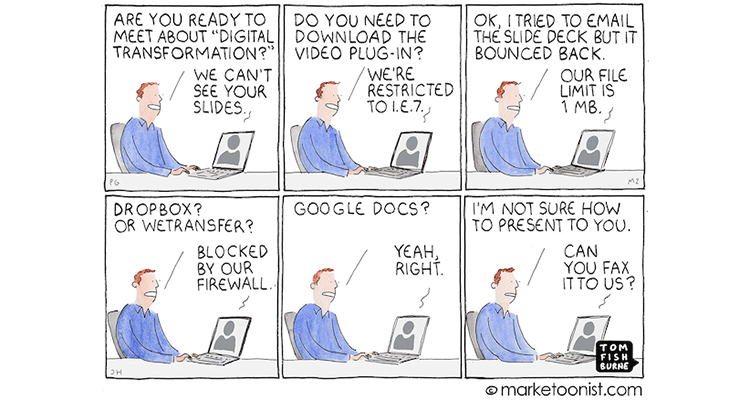Situational Awareness, Part 2: The Technology Lag Factor
Scott Brinker, editor at chiefmartec.com, better known as the Chief Marketing Technologist blogger, said in a recent post, “The funny and frustrating truth is that organizations change (far) more slowly than technology.” In fact, the speed of technology uptake (or change) is usually a fraction of the speed at which the technology is actually evolving.
Brinker’s well-written and thoughtful blog usually focuses on analyzing topics at the intersection of marketing, technology and management. But the conclusions he draws are surprisingly applicable directly to our world as revealed by the cartoon he originally included with his post, shown below.

Courtesy marketoonist.com
While the cartoon speaks for itself and the point is clear, let’s look at this issue from a slightly different perspective.
The Dangerous Assumption of Compatibility
As the communication situation in the cartoon clearly illustrates, as an industry we and our vendors assume everyone is “up-to-date” on their software, hardware and related issues. Let’s be very, very clear about this — they aren’t.
In fact they may well be much further behind the current state of the art than you could begin to imagine. To illustrate let me use an example from another world — the medical office operations business.
Hand Carried
Recently, a colleague was scheduled for some minor medical tests and asked me to accompany them as they were to be given a local anesthetic and couldn’t drive home afterwards. When we got to the outpatient facility for the testing, they were scrambling to find his up-to-date blood test data, which his primary care doctor had done the week before. They were not in the file or anywhere in his computerized records, according to the front desk. Yet we knew they had been done and he had a copy (at home of course) and was wondering why they weren’t available.
A few probing questions quickly provided the mind-boggling answer. His doctor’s office was still using their very comfortable but old records software, which had been supplied by a division of GE a decade earlier. It was based on a Windows XP kernel, and since it was working fine, that office saw no reason to change.
But the hospital with which they were affiliated, and where the tests were being done, had updated its systems a few months before to the new version of that same software (which by the way was written around and using a Windows 7 kernel).
Is the fog of confusion lifting? The two systems could not communicate with each other, and neither office had bothered to notify the other that the records had been sent but not received, nor had they bothered to check to see if there was a problem, until the moment my colleague showed up at the front desk to check in.
Now here’s where it gets ugly. The hospital’s solution was to re-do all the same tests done a week earlier, at considerable (not covered) cost so they could complete the test. My colleagues’ insurance wouldn’t pay twice for the same tests a week apart — logically so.
An impasse resulted, until one of the nurse assistants thoughtfully volunteered to walk across the street to the other office and pick up a physical copy of the results and hand carry them back to the testing offices — avoiding considerable expense and two or three hours of wasted time repeating something that didn’t need repeating.
Sometimes a logical answer eludes those involved because they are looking for a technical solution not a solution- period.
Assuming Functionality
While the example above might seem a bit extreme given the senior citizen status of the software involved, it’s frankly not. The number of large corporate entities who are still using officially deceased versions of both operating systems and other programs because they work and they see no reason to update (which often comes at considerable cost and expense) is astonishingly high, according to surveys conducted by several major corporate management groups and trade associations.
Living with legacy hardware and software because there is no perceived need to update or change is a common and easily justified practice. The justification is really simple — no expenses required. It’s working just fine so why do anything?
If you think it’s just small or even mid-sized businesses that are lagging behind the update curve — think again. Probably the biggest offender in this area is the federal government. You may recall that until very recently both the IRS and the FAA were using decades-old computer systems, whose maintenance had become a nightmare because the parts were long discontinued, and the people who designed and built the systems were either seriously retired or not on the planet anymore so very few knew how to fix these ancient (in some cases still DOS-based!) systems.
Only when it became literally impossible to keep things running did changes occur. Even then it was grudgingly implemented, badly rolled out and ended up costing multiple times what it should have. It was incredibly difficult to move the data and files from what amounted to 30+ year-old file systems into a more modern database structure — so complex, in some cases, that all the data had to be re-entered by hand, one file at a time.
Back in AV/IT Land
Now it may seem that such reluctance and resistance to change would be bad for business, but it’s actually not. Just a week or so ago we were dealing with a small specialty metal fabrication company located not too far from our offices in the Kansas City metro area.
This company is VERY small (five employees, family owned, etc.) and does really excellent work on custom metal faceplates and similar items. However, they don’t have much in the way of “modern” software or hardware — you can’t just send them an AutoCAD file by email for example, or even email much of anything as they still have old AOL email addresses with serious file size limits.
They simply don’t see the need to update — if you want to do business with them you literally USPS or Fed Ex them actual paper drawings of what you want and astonishingly they get it done in a day or two and it’s always perfect.
I asked the owner why he doesn’t update to more current software/systems and his answer was — “I don’t need to! If you want us to do the work, work with us the way we work or find somebody else. We do it our way, always have, always will — we simply don’t need to be modern, we focus on quality not technology!” I found it pretty hard to argue with that logic, especially given the old world craftsmanship and consistent perfection he manages to produce doing it “his way.”
If you don’t know what level of technology your customer is using or comfortable with you will more than likely run into a problem you don’t want or need to have. The solution is really amazingly simple — ask!





